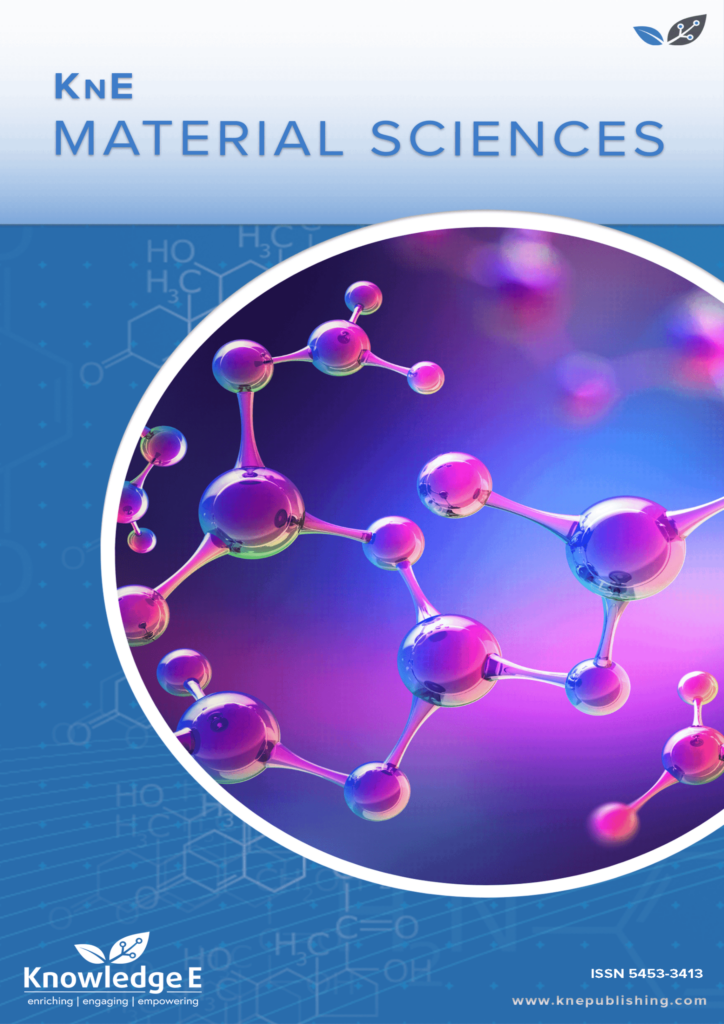
KnE Materials Science
ISSN: 2519-1438
The latest conference proceedings on physical materials, energy materials, electrical materials.
Investigation of Agricultural Waste as Economical and Effective Bio-Inhibitors for Inhibiting Scaling in Natural Hard Water
Published date: Aug 10 2022
Journal Title: KnE Materials Science
Issue title: 1st International FibEnTech Congress (FibEnTech21) – New Opportunities for Fibrous Materials in the Ecological Transition
Pages: 146–156
Authors:
Abstract:
In this study, agricultural waste was utilized as new bio-inhibitors to prevent scale formation in hard waters. Aqueous extracts of strawberry and tomato leaves were utilized for reducing the scale deposits formed on metallic surfaces by Bounouara ground hard water, which supplies Constantine city in Algeria. Anti-scaling properties were evaluated by chronoamperometry and impedancemetry techniques. The effect of temperature and concentration on the efficiency of the bio-inhibitors was assessed. The results showed that the anti-scaling effect of strawberry leaf extracts started at the very low concentration of 1 ppm, with 31% efficiency, reaching complete scaling inhibition at 15 ppm (20ºC), whereas the inhibitory effect of tomato leaf extracts was noticed at 2.5 ppm, with 36% efficiency, and total inhibition at 20 ppm (20ºC). The efficiency of strawberry and tomato leaf extracts at 40∘C was also confirmed, although total inhibition was attained at a higher concentration.
Keywords: hard water, agricultural waste, strawberry leaves, tomato leaves, bioinhibitors, scaling inhibition
References:
[1] Rosset R, Sok P, Poindessous G, Amor MB, Walha K. Caractérisation de la compacité des dépôts de carbonate de calcium d’eaux géothermales du Sud tunisien par impédancemétrie. Comptes Rendus De L’académie Des Scinces.-Serie IIC-Chemestry. 1998;1:751–759. https://doi.org/10.1016/S1251-8069(99)80041-3
[2] Bouchkima B. L’eau de la nappe albienne du sud algérien. Paper presented at: Journées Technique et Scientifique sur la Qualité Des Eaux du Sud; 2003 Mai 19– 20; El-Oued, Algerie.
[3] Rakitin AR, Kichigin VI. Electrochemical study of calcium carbonate deposition on iron. Effect anion. Electrochimica Acta. 2009;54(9):2647–2654. https://doi.org/10.1016/j.electacta.2008.10.064
[4] Wang C, Shu-ping L, Tian-duo L. Calcium carbonate inhibition by a phosphonate-terminated poly(maleic-co-sulfonate). Desalination. 2009;(1)249:1–4. https://doi.org/10.1016/j.desal.2009.06.006
[5] Chauhan K, Kumar R, Kumar M, Sharma P, Chauhan GS. Modified pectin-based polymers as green antiscalants for calcium sulfate. Desalination. 2012;305:31–37. https://doi.org/10.1016/j.desal.2012.07.042
[6] Asif M, Faizur R, Hafiz ZS, Syed MZ. Scaling of reverse osmosis membranes used in water desalination: Phenomena, impact, and control; future directions. Desalination. 2019;455:135–157. https://doi.org/10.1016/j.desal.2018.12.009
[7] Goh PS, Lau WJ, Othman MHD, Ismail AF. Membrane fouling in desalination and its mitigation strategies. Desalination. 2018;425:130–155. https://doi.org/10.1016/j.desal.2017.10.018
[8] Demadis KD, Neofotist E, Mavredaki E, Tsiknakis M, Sarigiannidou E-M, Katarachia SD. Inorganic foulants in membrane systems: Chemical control strategies and the contribution of green chemistry. Desalination. 2005;179:281–295. https://doi.org/10.1016/j.desal.2004.11.074
[9] Lin W, Colin C, Rosset R. Caractérisation du pouvoir incrustant d’une eau par chronoampérométrie au potentiel optimal d’entartrage. TSM-L’eau; 1990.France.
[10] Gabrielli C, Keddam M, Khalil A, Rosset R, Zidoune M. Study of calcium carbonate scales by electrochemical impedance spectroscopy. Electrochimica Acta. 1997;42(8):1207–1218. https://doi.org/10.1016/S0013-4686(96)0028-7
[11] Ketrane R, Leleyter L, Baraud F, Jeannin M, Gil O, Saidani B. Characterization of natural scale deposits formed in southern Algeria groundwater. Effect of its major ions on calcium carbonate precipitation. Desalination. 2010;262(1–3):21– 30https://doi.org/10.1016/j.desal.2010.05.019
[12] Ben-aazza S, Hadfi A, Mohareb S et al. Geochemical characterization and thermodynamic study of water scaling phenomenon at Tiznit Region in Southern Morocco, Groundwater for Sustainable Development. 2020;11:100379 (1-6). https://doi.org/10.1016/j.gsd.2020.100379
[13] Zeppenfeld K. Prevention of CaCO3 scale formation by trace amounts of copper (II) in comparison to zinc (II). Desalination. 2010;252:60–65. https://doi.org/10.1016/j.desal.2009.10.025
[14] Gu X, Qiu F, Zhou X et al. Synthesis and application of terpolymer scale inhibitor in the presence of β-cyclodextrins. Journal of Petroleum Science and Engineering. 2013;109:177–186. https://doi.org/10.1016/j.petrol.2013.08.021
[15] Boulahlib-Bendaoud Y, Ghizellaoui S, Tlili M. Inhibition of CaCO3 scale formation in ground waters using mineral phosphates. Desalination and Water Treatment. 2012;38:271–277. https://doi.org/10/5004/dwt.2012.1430
[16] Belattar M, Hadfi A, Ben-Aazza S et al. Efficiency of one scale inhibitor on calcium carbonate precipitation from hot water sanitary: Effect of temperature and concentration. Heliyon. 2021;7:e06152 (1-6). https://doi.org/10.1016/j.heliyon.2021.e06152
[17] Anastas PT, Warner JC. Green chemistry: Theory and practice. New York: Oxford University Press; 1998. [18] Darling D, Rakshpal R. Green chemistry applied to corrosion and scale inhibitors. Materials Performance. 1998;37:42–45.
[19] Thatcher M, Payne G. Impact of the OSPAR decision on the harmonised mandatory control scheme on the offshore chemical supply industry. Manchester: RSC &EOSCA; 2005.
[20] Ledion J, Leroy P, Labbe JP. Détermination du pouvoir incrustant d’une eau par un essai d’entartrage accéléré. Techniques Sciences Méthode(TSM) -L’eau. 1985:323- 328.
[21] Semine Ras H, Ghizellaoui S. Determination of anti-scale effect of hard water by test of electrodeposition. Procedia Engineering. 2012;33; 357–365. https://doi.org/10.1016/j.proeng.2012.01.1215.
[22] Ketrane R, Saidani B, Gil O, Leleyter L, Baraud F. Efficiency of five scale inhibitors on calcium carbonate precipitation from hard water: Effect of temperature and concentration. Desalination. 2009;249(3):1397–1404. https://doi.org/10.1016/j.desal.2009.06.013
[23] Zidoune M, Khalil A, Sakya P, Colin C, Rosset R. Mise en évidence de l’effet antiincrustant de l’acide aminotris (méthylènephosphonique) par chronoampérométrie et chronoélectrogravimétrie. Electrochimie. C.R. Academy of Science. 1992;315(2):795– 799.